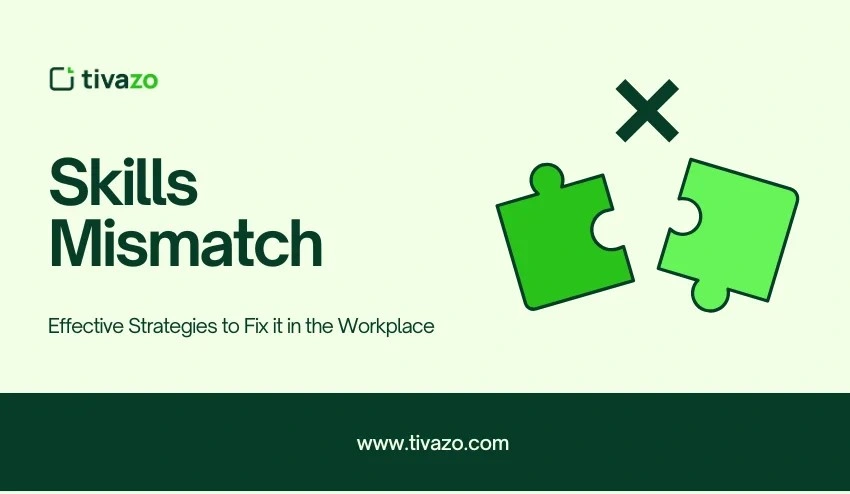In today’s fast-paced workplace, companies face a crucial skills mismatch. This occurs when employees fail to have the right skills for their positions, resulting in inefficiency, frustration, and inertia. According to the ManpowerGroup survey 2024 Talent Shortage, 75% of employers say it is difficult to fill roles. This issue is tied very closely to this growing and oftentimes frustrating workplace mismatch. Understanding what skills mismatch means (and how to correct it) can result in positive outcomes to your organization for 2026 and beyond.
Key Highlights:
- What Is Skills Mismatch
- How do skills mismatches happen
- Types of Skills Mismatches
- Common Causes of Skills Mismatches
- How to Identify Skills Mismatch in Your Organization
- Practical Solutions to Bridge the Skills Mismatch Gap
- Skills Mismatch vs Skills Gaps vs Skills Shortages
- importance of addressing skills mismatches
What Is Skills Mismatch and Why It Matters
Skills mismatch happens on the grounds that there is a mismatch between the employee’s skills are, and the skills required to do the job. Misalignment of skills is sometimes simply putting employees into a role that doesn’t call for their very best, and their skills are underutilized, disengaged, and frustrated. Alignment can take place for a variety of reasons:
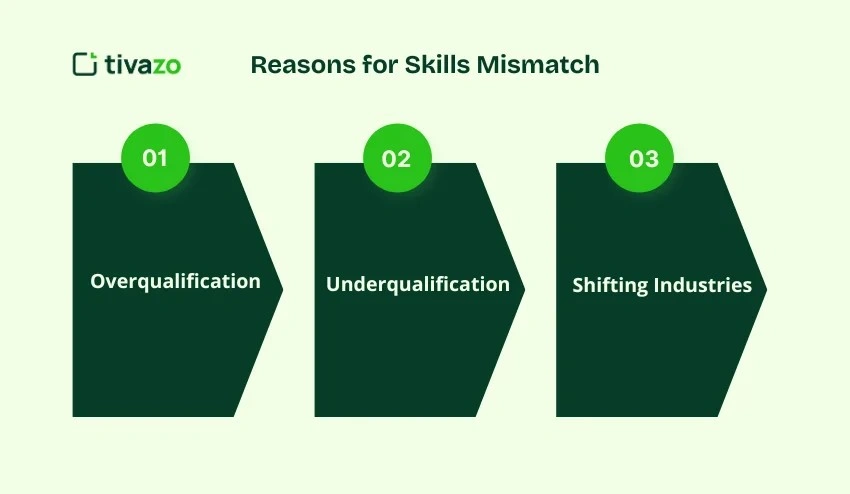
- Overqualification: Employees have more advanced skills than the job requires, rendering their skills idled.
- Underqualification: Employees do not have the skills required to be effective in their role.
- Disruptive industries: The pace of change with technology and onboarding may leave employees’ skills not just changed but obsolete in terms of practical experience and relevance.
Whether through outdated skills, no favorable education, or an explosion of change, skills mismatch can impact productivity, satisfaction, and retention, which translates to high costs and lost opportunity.
How do skills mismatches happen?
Developments in skills mismatches can result from a number of issues. Addressing problems with the cause of mismatches can help organizations deal with mismatches more effectively. Skills mismatches may occur due to a lack of clarity in job requirements and descriptions, inconsistent hiring practices, education systems, and shifts in technology. Below are factors of why skills mismatches.
- Issues with Hiring: Sometimes job descriptions are not very clear, or the job description did not really require the indicated skills, resulting in attracting applicants that were either overqualified or underqualified.
- Rapid Technology Changes: The skill set required may shift over time. Workers may not have had an opportunity to obtain skills related to rapidly changing data sets and technology demands.
- Obsolete Education Models: Skills mismatches sometimes occur because formal education does not provide today’s job market with the latest constructivist skills while meeting industry qualifications.
- Change/Developments in Industry: When industries, such as automotive manufacturing, shrink or change, workers specifically skilled in a certain industry often struggle to utilize the same educational flair in newer careers and industries.
Acknowledging these measured factors beyond the organization’s labor force is important for companies interested in creating workers who are aligned with the company’s long-term strategy and market forces.
The 3 Types of Skills Mismatches You Should Know
Recognizing the skill-mismatch problems can help to ameliorate the situation strategically:
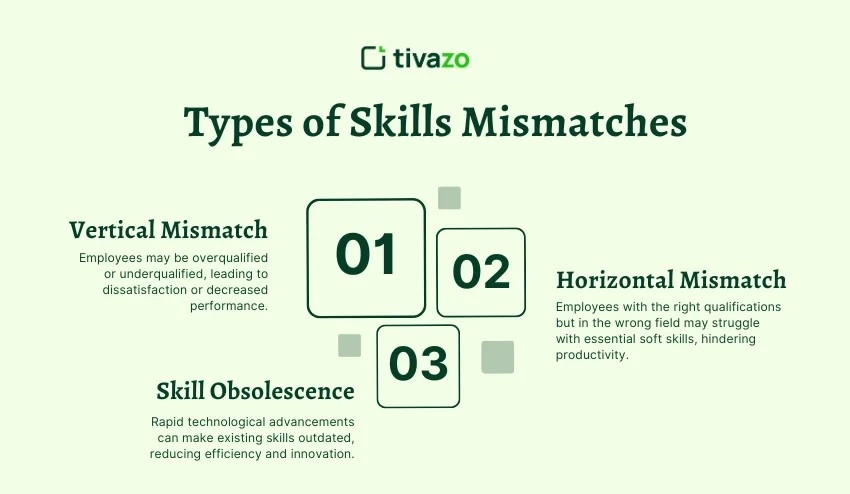
1. Vertical Mismatch
An employee is either over or underqualified for the role. For example, a seasoned manager may find themselves in a low-level position, leading to unhappiness and frustration from his or her training, talent, and insights being underused. Alternatively, a newly hired employee does not have the requisite skills, which causes the team to not function at its best and also costs time and productivity as others may need to help train the new employee.
2. Horizontal Mismatch
This occurs when the employee is qualified, but in a different field. For example, a person who was an IT manager for 10 years could be hired to work with customers, but probably has fewer or no soft skills for customer service or engagement, let alone managing a team. While this person will likely perform technical tasks well (indeed, their technical knowledge may have been a factor in hiring them), their inexperience with engaging, inspiring, and/or managing their teams or stakeholders will probably form a bottleneck to the team being able to successfully collaborate, which ultimately has an impact on the organization’s overall success and bottom line.
3. Skill Obsolescence
Advances in technology are occurring at a previously unimagined pace, and as a result, individuals are finding themselves in jobs in which their skills are becoming obsolete. Employees who do not upgrade or acquire additional training on specific skills may find themselves at a disadvantage because they cannot keep up with the industry’s demands or changes driven by technology. This is especially true in industries like technology, healthcare, and manufacturing, where rapid changes can eliminate the value of specific skills in a matter of months, resulting in inefficiency and a failure to take advantage of competitive, innovative opportunities.
Common Causes of Skills Mismatches
To remediate skills mismatches, we must first understand what is driving the skills mismatch dilemma. The following factors contribute to the growing skills mismatch problem:
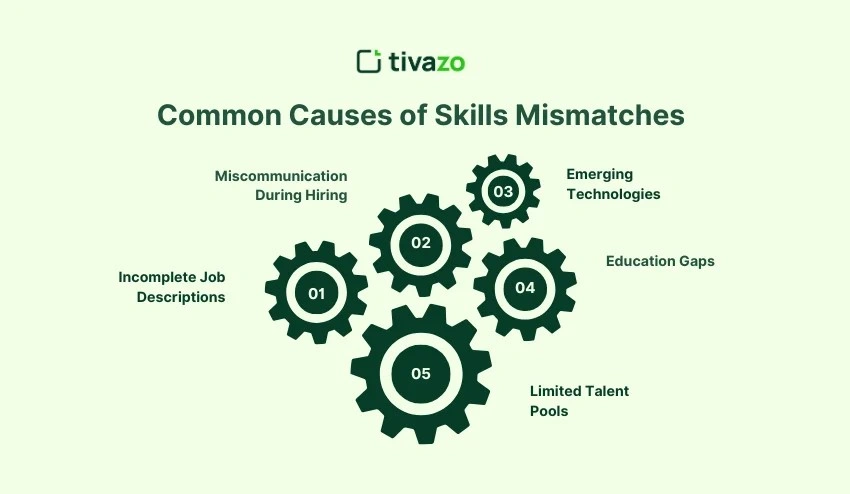
- Incomplete Job Descriptions: Job postings that do not have skill definitions can entice underqualified candidates, but they can also entice candidates who are overqualified for the role.
- Miscommunication During Hiring: Employees in HR and hiring managers may not have clear communication as part of their hiring process, causing the employer to fail to properly assess the applicant’s skills.
- Emerging Technology: Rapid use of new tools and/or platforms can contribute to skill gaps due to the lack of time within employees’ duties to learn the skills necessary to stay competitive.
- Educational Defects: Conventional schools/educational systems are not adequately preparing students with the most current career-ready skills.
- Talent Shortage: For specialized roles, finding candidates with the desired skills can be difficult.
How to Identify Skills Mismatch in Your Organization
It is critical to recognize skills mismatch as early as possible to avoid long-term negative consequences for your business. The following indicators may indicate that there is a skills mismatch occurring in your organization:
- Employee Engagement Issues: Disengaged employees are often an indicator that they feel unchallenged or undervalued in their positions.
- Declined Productivity: When employees do not have the appropriate skills to complete assigned tasks, productivity will decline.
- Increased Turnover: Employee turnover is less likely to increase if they feel like the skills they have are not valued or being used in the position.
- Difficulties in Recruitment: When there is a lack of talent or an inability to find a candidate who is the right-fit candidate, it is often related to a skills mismatch issue.
Recognizing these issues early can help organizations identify effective methods to address skills mismatch through reskilling programs, adjustments to the recruitment process, and more targeted training.
Practical Ways to Bridge the Skills Mismatch Gap
Now that we have examined the issue, let’s turn our attention to how you can resolve the skills mismatch in your organization:
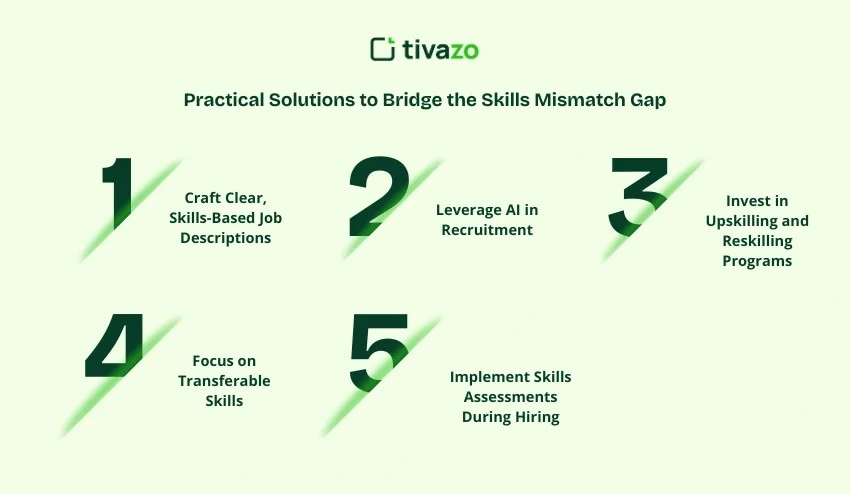
1. Craft Clear, Skills-Based Job Descriptions
The job description should focus on specific skills and not just qualifications. Use action verbs to emphasize, and be specific with skill levels (intermediate, advanced) so as not to attract the wrong candidates.
- Clearly describe the required technical skills, soft skills, and industry-specific skills.
- Incorporate specific examples of tasks employees will perform so the candidate is legally aligned with your expectations.
- Update job descriptions regularly in order to keep pace with the fluid nature of the industry.
2. Leverage AI in Recruitment
AI tools such as resume screening software will assist you in determining candidates’ skills more accurately and quickly. AI skill assessments may even provide a deeper level of candidate profiling to make the right hire for your position and avoid mismatches.
- Use AI to screen all applicants to eliminate candidates based on the experience and skill set required.
- Use AI in your skill assessment integrations so you can actually take skill content tests to ensure candidates can perform the tasks required for the role.
- Use AI for evaluating skills to mitigate human bias and first impressions.
3. Invest in Upskilling and Reskilling Programs
It is important to think proactively about advancing skills. Provide continuous training programs, on-the-job experience, and online training courses to allow individuals in your workforce to remain competitive and up to date in their field.
- Create an individualized development plan based on role and objectives.
- Encourage mentorship programs for employees and allow knowledge-sharing opportunities.
- Provide online learning platforms for self-paced training around how technology and trends in the workplace are evolving in the future.
4. Focus on Transferable Skills
Transferable skills such as problem-solving, communication, and critical thinking are important transferable skills across industries. Hiring individuals who carry transferable skills creates opportunities for improvement of the organization, which, as a result, leads to possible increases in employee satisfaction, retention, etc.
- Highlight valuable skills that allow workers to be successful in a variety of job functions
- Provide cross-functional learning opportunities for employees to work on interdepartmental jobs
- Create an environment that not only allows for collaboration but also encourages continuous learning.
5. Implement Skills Assessments During Hiring
Skills assessments, both technical and soft skills, allow you to evaluate candidates on their actual performance instead of merely their resumes. You could also consider a time-tracking platform such as Tivazo Time Tracking for additional real-time insight into your candidates’ skills and productivity.
- Create assessments or tests around the role to evaluate how candidates can perform learned skills in a practical setting.
- Use the time-tracking tool to watch productivity and performance in the skills-assessing stage.
- Get feedback from team members who interacted with the candidate to see how their soft skills were in the interview.
Skills Mismatch vs Skills Gaps vs Skills Shortages
Although the phrases “skills mismatch,” “skills gap,” and “skills shortage” are often used interchangeably, they each face their own unique hurdle. It is important to understand these distinctions so you are able to facilitate workforce issues. Here is how they differ:
Skills Mismatch
- Cause: Employees’ skills do not meet the needs of the job, being either overqualified or underqualified.
- Result: Decreased job satisfaction, decreased productivity, or disengagement.
- Solution: Write better job descriptions, assess the employees’ skills, train employees, or reskill employees.
Skills Gap
- Cause: Employees are missing certain competencies required by their position as a result of their education or training being outdated.
- Result: Decreased job performance, ineffectiveness, or delays in projects.
- Solution: Provide employees with ongoing learning programs, workshops, or additional on-the-job training to fill the gap.
Skills Shortage
- Cause: The candidate pool for an open position is small, or there are no qualified candidates to fill the open position, usually due to high-demand skills.
- Result: Not being able to hire, competition for talent, or missed opportunities.
- Solution: Expand your reach in recruiting, partner with learning institutions like a university and college, and create attractive employment benefits to lure candidates.
Future Trends: The Evolution of Skills Mismatches
Due to the constant shift of industry trends, the type of skills mismatches will evolve as well. We are seeing an increase in the use of automated tools, AI-based workspaces, and hybrid roles. Keeping ahead of these trends by preparing future-proof skills think data analysis, machine learning, and digital literacy, will help your organization continue to be competitive. Organizations should also develop a culture of continuous learning for employees to become developmental thinkers, adapting to these changes while avoiding skills mismatches. Not only does preparing your employees for future trends help you address current problems, but it also positions your company for future success.
The importance of addressing skills mismatches
Resolving skills mismatches is about productivity but is also about developing a more efficient and innovative workforce. When employees are matched to their roles, the benefits are much more than an individual level, even if it shows productive upturns. Why skills mismatch should be a priority for your business:
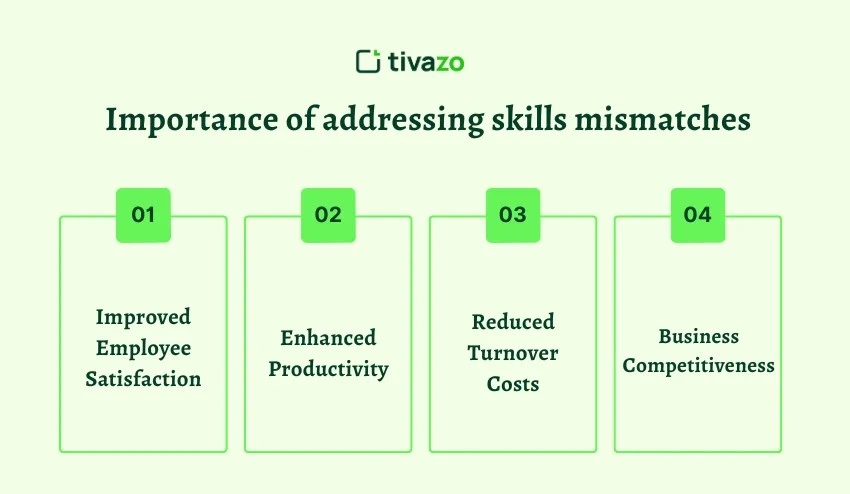
- Improved Employee Satisfaction: When the employee’s skills match their role, there is generally a greater overall workforce fulfillment. Combined with job satisfaction, employee engagement will increase, leading to improved retention.
- Enhanced Productivity: When individuals are supplemented with the right skillsets, teams become more productive, projects take less time, and run with a lower error rate. Team members with the right skillsets will also take on more responsibility, resulting in growth within the organization.
- Decreased Turnover Costs: Employees who are challenged and supported are likely to stay employed. This ultimately means lower turnover costs related to recruiting and onboarding.
- Business Competitiveness: Companies that appropriately handle skill mismatches can also adapt to changes in the market as they happen, stay ahead of competitors, and increase their capacity to continuously innovate.
Businesses that fix skills mismatches can ensure smooth operations today and also best position themselves to be future-proofed in a rapidly evolving marketplace. Investing in proper skills development strategies will provide organizations with resilient and flexible workers who can be champions of change.
Conclusion: Taking Action Now to Solve Skills Mismatches
The skills mismatch is a real and ever-growing challenge; however, it is an opportunity for companies to improve their team’s productivity, job satisfaction, and retention. By rectifying the issue proactively – clearly understanding and developing job descriptions, using AI to guide hiring to jobs at pace, and ongoing skill development of the employees – you can future-proof your employment options in a rapidly competitive labour market.
If you are ready to step up and optimize your recruitment process for skills-based hiring as a pillar of your HR practice today. Support your team to flourish and adapt in their roles in 2026, and likely many years onward.
